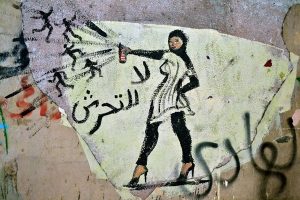
Graffiti is defined by the Webster’s Dictionary as “usually unauthorized writing or drawing on a public surface.” The word alone implies a sense of criminal activity. It is easy to pair the term with an image of a masked artist, spraying paint onto the side of an abandoned facility. This negative connotation was constructed by social norms that were formed by laws and policy. It is no surprise that uncommissioned works of public art, specifically through the use of paint and spray paint, are typically classified as “graffiti” or acts of vandalism.
However, the term “street art” conjures up a completely different image. One would envision sprawling murals, full of color. “Art” implies a thing of beauty or something to be admired or respected. For the purpose of my thesis research, I considered the public works of art that I studied to be “street art” as opposed to “graffiti.” Yes, it is true that the majority of these works were not legally commissioned, nor did the artists always receive explicit permission from the owner of the property. In addition, it is likely that the government of the country in which the art is being produced censors the ideologies that are being expressed in the given work of art. However, these images are a way to distribute ideologies. In addition, the street provides artists with a large audience–which can be even further expanded upon once images or videos are posted to social media platforms and blogs. It’s also incredibly accessible. Street art is publically displayed for the masses to consume. One does not need to purchase admission to a ritzy gallery, nor does the artist need to spend significant funds on supplies or fees.
Widewalls, a website that devotes itself to the study and analysis of contemporary art across the globe, believes that there are two main components to a piece of “street art”:
Each artist and each work I decided to include in my research have all three of these components. The public art clearly emphasizes social activism. Most of the time, this is obvious in the message of the piece itself. The works will depict a political figure that the artist believes should be ousted, or will depict everyday citizens mobilizing together to create change within their communities. In addition, for the second clause, all of the artwork I included clearly does impact the classification of “contemporary art”. All of the works focus on a conflict that at the time was ongoing. Furthermore, the act of public art on buildings or public space was illegal in most of the countries I studied. That means that the artists were changing the artistic norms of their culture for that given time frame. And finally, for the third component, clearly all these works shaped the political landscape during these conflicts. Whether they were created in countries that saw relatively successful revolutions, like Tunisia, or if they were created in countries that have spiraled into civil war, like Syria, they all sparked a conversation. What do the people want from the revolution? What areas in social and political matters need improvement? Where do we–as a collective group–go from here?
In order to see works from different artists within each of the countries of study, explore the tabs at the top of the site.